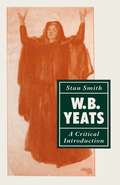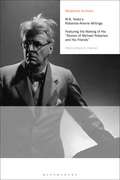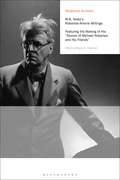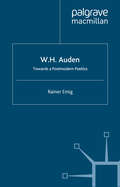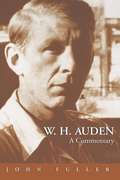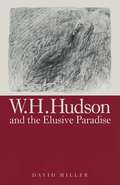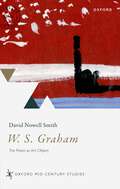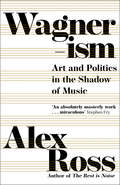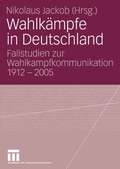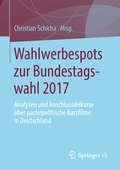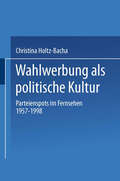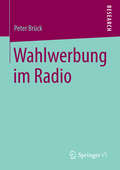- Table View
- List View
W. B. Yeats: A Critical Introduction
by Stan SmithThis study not only helps the student to understand Yeats's poetry, but also offers, in straightforward, untechnical language, a practical guide on how to write about it critically. In the process, it offers many original readings of the poems, and emphasises the urgency and contemporaneity of Yeats's work.
W.B. Yeats, Ezra Pound, and the Poetry of Paradise
by Sean PryorEmphasizing the interplay of aesthetic forms and religious modes, Sean Pryor's ambitious study takes up the endlessly reiterated longing for paradise that features throughout the works of W. B. Yeats and Ezra Pound. Yeats and Pound define poetry in terms of paradise and paradise in terms of poetry, Pryor suggests, and these complex interconnections fundamentally shape the development of their art. Even as he maps the shared influences and intellectual interests of Yeats and Pound, and highlights those moments when their poetic theories converge, Pryor's discussion of their poems' profound formal and conceptual differences uncovers the distinctive ways each writer imagines the divine, the good, the beautiful, or the satisfaction of desire. Throughout his study, Pryor argues that Yeats and Pound reconceive the quest for paradise as a quest for a new kind of poetry, a journey that Pryor traces by analysing unpublished manuscript drafts and newly published drafts that have received little attention. For Yeats and Pound, the journey towards a paradisal poetic becomes a never-ending quest, at once self-defeating and self-fulfilling - a formulation that has implications not only for the work of these two poets but for the study of modernist literature.
W.B. Yeats, Ezra Pound, and the Poetry of Paradise
by Sean PryorEmphasizing the interplay of aesthetic forms and religious modes, Sean Pryor's ambitious study takes up the endlessly reiterated longing for paradise that features throughout the works of W. B. Yeats and Ezra Pound. Yeats and Pound define poetry in terms of paradise and paradise in terms of poetry, Pryor suggests, and these complex interconnections fundamentally shape the development of their art. Even as he maps the shared influences and intellectual interests of Yeats and Pound, and highlights those moments when their poetic theories converge, Pryor's discussion of their poems' profound formal and conceptual differences uncovers the distinctive ways each writer imagines the divine, the good, the beautiful, or the satisfaction of desire. Throughout his study, Pryor argues that Yeats and Pound reconceive the quest for paradise as a quest for a new kind of poetry, a journey that Pryor traces by analysing unpublished manuscript drafts and newly published drafts that have received little attention. For Yeats and Pound, the journey towards a paradisal poetic becomes a never-ending quest, at once self-defeating and self-fulfilling - a formulation that has implications not only for the work of these two poets but for the study of modernist literature.
W.B. Yeats's Robartes-Aherne Writings: Featuring the Making of His "Stories of Michael Robartes and His Friends" (Modernist Archives)
by Wayne K. ChapmanThe figures of Michael Robartes and Owen Aherne appear throughout the writing of the great Irish poet W.B. Yeats, featuring in his poems, short fictions, dialogues and as authorities in notes to his work. Bringing together into one volume published and unpublished writings featuring these two enigmatic figures, W.B. Yeats's Robartes-Aherne Writings traces their history and the development of Yeats's mystical thought that culminated (twice) in the publication of his visionary work A Vision (1925, 1937). Including reproductions of manuscript and notebook pages as well as transcriptions and extracts from a wide range of Yeats's mystical writings and substantial commentary and annotation throughout, this book is an essential resource for scholars of Yeats's thought, his stylistic evolution and the esoteric influences on modernist writing in the early 20th century.
W.B. Yeats's Robartes-Aherne Writings: Featuring the Making of His "Stories of Michael Robartes and His Friends" (Modernist Archives)
by Wayne K. ChapmanThe figures of Michael Robartes and Owen Aherne appear throughout the writing of the great Irish poet W.B. Yeats, featuring in his poems, short fictions, dialogues and as authorities in notes to his work. Bringing together into one volume published and unpublished writings featuring these two enigmatic figures, W.B. Yeats's Robartes-Aherne Writings traces their history and the development of Yeats's mystical thought that culminated (twice) in the publication of his visionary work A Vision (1925, 1937). Including reproductions of manuscript and notebook pages as well as transcriptions and extracts from a wide range of Yeats's mystical writings and substantial commentary and annotation throughout, this book is an essential resource for scholars of Yeats's thought, his stylistic evolution and the esoteric influences on modernist writing in the early 20th century.
W. C. Fields from Burlesque and Vaudeville to Broadway: Becoming a Comedian (Palgrave Studies in Theatre and Performance History)
by A. WertheimW. C. Fields was a virtuoso comedian, often called a comic genius, legendary iconoclast, and "Great Man," who brought so much laughter to millions while enduring so much anguish. This book explores his little-known, long stage career from 1898 to 1930, which had a major influence on his comedy and screen presence.
W.G. Sebald-Handbuch: Leben - Werk - Wirkung
by Claudia Öhlschläger Michael NiehausTrotz seines schmalen Œuvres wurde kein deutschsprachiger Autor der Gegenwartsliteratur international so intensiv und kontrovers diskutiert wie W.G. Sebald, der fünfzehn Jahre nach seinem Tod bereits zum kanonischen Autor geworden ist. Die Beiträge namhafter Sebald-Forscher erschließen in diesem Handbuch die verschiedenen Facetten und Ebenen des gesamten literarischen und essayistischen Werks. Sebalds Themen (Trauma und Erinnerung, die Naturgeschichte der Zerstörung, Holocaust, Heimat) werden ebenso beleuchtet wie die Merkmale seines Schreibens (Intertextualität, Bastelei, Verbindung von Text und Bild, Stil), seine Leitmotive (Melancholie, Reisen) sowie die Präsenz anderer Medien und Künste (Photographie, Malerei, Architektur) in seinen Texten. Eigene Teile sind den für Sebald wichtigsten Referenzautoren und der nationalen und internationalen Rezeption gewidmet.
W.H. Auden: Towards A Postmodern Poetics
by R. EmigThis study reads Auden's poetry and plays through the shifts from modernism to postmodernism. It analyses the experiments in Auden's writings for their engagement with crucial contemporary problems: that of the individual in relation to others, loved ones, community, society, but also transcendental truths. It shows that rather than providing firm answers, Auden's poetry emphasises the absence of certainties. Yet far from becoming nihilistic, it generates hope, affection, and most importantly an ethical challenge of responsibility out of its discoveries.
W. H. Auden: A Commentary
by John FullerThis is an indispensable reference guide to the works of one of the most important poets of the twentieth century. W. H. Auden's writing is notoriously complex--full of puzzling allusions and shaped by influences as diverse as Old English poetry and Auden's own theory of psychosomatic illness. To help readers understand Auden's work, the poet and scholar John Fuller examines all of Auden's published poems, plays, and libretti, leaving out only some juvenilia. In unprecedented detail, he reviews the works' publishing history, paraphrases difficult passages, and explains allusions. He points out interesting variants (including material abandoned in drafts), identifies sources, looks at verse forms, and offers critical interpretations. Along the way, he presents a wealth of facts about Auden's works and life that are available in no other publication. The book is a major revision of Fuller's critically acclaimed Reader's Guide to Auden, published in 1970. It contains more than twice the material of that earlier volume. Fuller organizes the book on the basis of the individual collections that Auden himself originally published, with sections of "uncollected" work interwoven. Clear, meticulously researched, and carefully designed for ease of use, it is an essential guide for anyone interested in Auden's remarkable and sometimes elusive writing.
W.H. Auden (Routledge Guides to Literature)
by Tony SharpeAs both a politically engaged and stylistically versatile poet, W.H. Auden is one of the most influential writers of the twentieth century. His work is not only widely studied and read, but has been used in musical scores and quoted in Hollywood films. This guide to Auden’s compelling work offers: an accessible introduction to the contexts and many interpretations of Auden’s texts, from publication to the present an introduction to key critical texts and perspectives on Auden’s life and work, situated in a broader critical history cross-references between sections of the guide, in order to suggest links between texts, contexts and criticism suggestions for further reading. Part of the Routledge Guides to Literature series, this volume is essential reading for all those beginning detailed study of W.H. Auden and seeking not only a guide to his works but also a way through the wealth of contextual and critical material that surrounds them.
W.H. Auden (Routledge Guides to Literature)
by Tony SharpeAs both a politically engaged and stylistically versatile poet, W.H. Auden is one of the most influential writers of the twentieth century. His work is not only widely studied and read, but has been used in musical scores and quoted in Hollywood films. This guide to Auden’s compelling work offers: an accessible introduction to the contexts and many interpretations of Auden’s texts, from publication to the present an introduction to key critical texts and perspectives on Auden’s life and work, situated in a broader critical history cross-references between sections of the guide, in order to suggest links between texts, contexts and criticism suggestions for further reading. Part of the Routledge Guides to Literature series, this volume is essential reading for all those beginning detailed study of W.H. Auden and seeking not only a guide to his works but also a way through the wealth of contextual and critical material that surrounds them.
W.S. Gilbert and the Context of Comedy: The Progress of Fun (Routledge Studies in Nineteenth Century Literature #1)
by Richard MooreTo what extent is a great comic writer the product of his time? How far is he (or she) influenced by factors of personal psychology upbringing and environment? To what is the writing actually part of a long continuum in which there is continuity within change and change within continuity? The Progress of Fun considers principally the last of these areas, focussing on the case of W.S. Gilbert and challenging the frequently held view that he is pre-eminently a typical Victorian. This it does by tracing his roots back to Ancient Greek comedy and to the various comedic developments that have dominated Western Europe thereafter. Also included is a careful examination of the constraints and limitations that in various forms have long affected comedy-writing, and an evaluation of Gilbert’s particular skills and legacy within the on-going process. The whole is a suitable prelude to a second volume (Pipes and Tabors) which will consider Genre in W.S. Gilbert, again relating it to comedic precedents and the universally timeless within the particular.
W.S. Gilbert and the Context of Comedy: The Progress of Fun (Routledge Studies in Nineteenth Century Literature #1)
by Richard MooreTo what extent is a great comic writer the product of his time? How far is he (or she) influenced by factors of personal psychology upbringing and environment? To what is the writing actually part of a long continuum in which there is continuity within change and change within continuity? The Progress of Fun considers principally the last of these areas, focussing on the case of W.S. Gilbert and challenging the frequently held view that he is pre-eminently a typical Victorian. This it does by tracing his roots back to Ancient Greek comedy and to the various comedic developments that have dominated Western Europe thereafter. Also included is a careful examination of the constraints and limitations that in various forms have long affected comedy-writing, and an evaluation of Gilbert’s particular skills and legacy within the on-going process. The whole is a suitable prelude to a second volume (Pipes and Tabors) which will consider Genre in W.S. Gilbert, again relating it to comedic precedents and the universally timeless within the particular.
W. S. Graham: The Poem as Art Object (Oxford Mid-Century Studies Series)
by David Nowell SmithOn the peripheries of UK poetry culture during his lifetime, W. S. Graham is now recognized one of the great poets of the twentieth century. In the first concerted study of Graham's poetics in a generation, David Nowell Smith argues that Graham is exemplary for the poetics of the mid-century: his extension of modernist explorations of rhythm and diction; his interweaving of linguistic and geographic places; his dialogue with the plastic arts; and the tensions that run through his work, between philosophical seriousness and play, solitude and sociality, regionalism and cosmopolitanism, the heft and evanescence of poetry's medium. Drawing on newly unearthed archival materials, Nowell Smith orients Graham's poetics around the question of the 'art object'. Graham sought to craft his poems into honed, finished 'objects'; yet he was also aware that the poem's 'finished object' is never wholly finished. Graham's work thus facilitates a broader reflection on language as a medium for art-making.
W. S. Graham: The Poem as Art Object (Oxford Mid-Century Studies Series)
by David Nowell SmithOn the peripheries of UK poetry culture during his lifetime, W. S. Graham is now recognized one of the great poets of the twentieth century. In the first concerted study of Graham's poetics in a generation, David Nowell Smith argues that Graham is exemplary for the poetics of the mid-century: his extension of modernist explorations of rhythm and diction; his interweaving of linguistic and geographic places; his dialogue with the plastic arts; and the tensions that run through his work, between philosophical seriousness and play, solitude and sociality, regionalism and cosmopolitanism, the heft and evanescence of poetry's medium. Drawing on newly unearthed archival materials, Nowell Smith orients Graham's poetics around the question of the 'art object'. Graham sought to craft his poems into honed, finished 'objects'; yet he was also aware that the poem's 'finished object' is never wholly finished. Graham's work thus facilitates a broader reflection on language as a medium for art-making.
W. S. Graham: Speaking Towards You (Liverpool English Texts and Studies #43)
by Ralph Pite Hester JonesGraham’s work was published by T. S. Eliot in the 1940s and 50s, but as a major post-war poet, his work has received astonishingly little critical attention given its prestige and influence. This collection of essays covers all aspects of Graham’s work – its critical reception, recent influence and its relations with other developments in the arts, in particular the work of the St Ives School of visual artists. It includes some biographical material (brief reminiscences by and interviews with those who knew him) and discussions of the material contained in several collections of manuscripts. Nothing so far published has paid attention to these manuscript collections or to the large number of uncollected poems published since his death. Neither has enough been written about Graham’s importance to poets of the 1980s and 1990s. ‘I first read a W. S. Graham poem in 1949. It sent a shiver down my spine. Forty-five years later nothing has changed. His song is unique and his work an inspiration.’ Harold Pinter
Wagnerism: How A Composer Shaped The Modern World
by Alex RossAlex Ross, renowned author of the international bestseller The Rest Is Noise, reveals how Richard Wagner became the proving ground for modern art and politics—an aesthetic war zone where the Western world wrestled with its capacity for beauty and violence.
Wahlkampf im Kontext: Negative Kampagnenstrategien in 58 Landtagswahlen
by Christina Angela RauhAnhand der wohl umfangreichsten Plakatdatenbank für Landtagswahlen zwischen 1998 und 2013 zeigt Christina Rauh: Wahlkampfkontexte wie eine steigende Arbeitslosigkeit haben einen messbaren Einfluss auf die Wahl der Kampagnenstrategie. Das Buch gibt umfangreiche Einblicke in Themen und Muster positiver und negativer Plakatwerbung von 264 Kampagnen aus 58 deutschen Wahlkämpfen. Es zeigt darüber hinaus Wege auf, die Wahlkampfforschung zukünftig stärker an Theorien rationaler Wählerkalküle auszurichten. So kann ein Modell der rationalen Kampagnenführung abgeleitet werden: Vertrauens- vs. Kontrollkommunikation sind seine beiden idealtypischen Strategien.
Wahlkampf in den Medien — Wahlkampf mit den Medien: Ein Reader zum Wahljahr 1998
by Christina Holtz-BachaDer Band versammelt zehn Beiträge über Untersuchungen zu verschiedenen Aspekten des modernen Medienwahlkampfes: Wie die politischen Akteure versuchen, die Medien für sich zu nutzen, wie die Medien mit dem Wahlkampf umgehen und welche Wirkungen Werbe- und Medienkampagne haben.
Wahlkämpfe in Deutschland: Fallstudien zur Wahlkampfkommunikation 1912 - 2005
by Nikolaus JackobDeutschland ist eine "verspätete" Demokratie, freie Wahlen und Wahlkämpfe prägen die Politik hierzulande erst seit einer vergleichsweise kurzen Zeit. Entsprechend jung ist auch das Forschungsfeld der Wahlkampfkommunikation. Während mittlerweile eine Fülle von Studien über die Wahlkämpfe seit den 1990er Jahren vorliegen, in denen das Kommunikationsmanagement umfassend dargestellt wurde, besteht für frühere Wahlkämpfe noch Nachholbedarf. In diesem Band wird eine episodenhafte Geschichtsschreibung der deutschen Wahlkampfkommunikation unternommen: Mit Fallstudien zu wichtigen Wahlkämpfen schlagen Autoren aus verschiedenen Wissenschaften einen Bogen vom Anfang des 20. Jahrhunderts bis heute.
Wahlwerbespots zur Bundestagswahl 2017: Analysen und Anschlussdiskurse über parteipolitische Kurzfilme in Deutschland
by Christian SchichaIn diesem Sammelband werden die Wahlwerbespots zur Bundestagswahl 2017 in Deutschland erstmalig aus unterschiedlichen Perspektiven verschiedener Fachdisziplinen wie der Medien- und Kommunikationswissenschaft, der Politikwissenschaft sowie der Pädagogik ausführlich analysiert. Dabei werden die Themen, Personen, Dimensionen des Politischen, Darstellungsformen, Erzähl- und Inszenierungsstrategien, normative Aspekte sowie ästhetische und dramaturgische Ausprägungen der Spots auch im historischen und länderübergreifenden Vergleich interpretiert und kontextuell eingeordnet.
Wahlwerbung als politische Kultur: Parteienspots im Fernsehen 1957–1998
by Christina Holtz-BachaWahlwerbung als ungefilterte Form der Selbstdarstellung der Parteien wird hier verstanden als politisches Sinn- und Deutungsangebot, mit dem die politischen Akteure versuchen, ihre Weltsicht bei der Wählerschaft durchzusetzen und damit deren Zustimmung zu gewinnen. In diesem Sinne wurde untersucht, wie sich die Wahlspots im Fernsehen über einen Zeitraum von etwa 40 Jahren entwickelt haben. Die Präsentation der Befunde ist eingebettet in eine Chronik der Bundestagswahlkämpfe sowie in einen Überblick zur Forschung über Wahlwerbung in den USA und in der Bundesrepublik Deutschland.
Wahlwerbung im Radio
by Peter BrückDas Radio ist, zusammen mit dem Fernsehen, das mit Abstand meist genutzte Medium in Deutschland. Auch die bundesdeutschen Parteien nutzen es häufig für ihre Werbung im Vorfeld von Wahlen. Trotzdem führt Wahlwerbung im Radio im Gegensatz zu Wahlwerbung auf und in anderen Trägermedien (z.B. Fernsehen, Internet) ein sozialwissenschaftliches Schattendasein. Vor diesem Hintergrund klärt Peter Brück die allgemeinen Voraussetzungen für Wirkungen von Wahlwerbung im Radio und erarbeitet ihre speziellen Wirkmechanismen. Er untersucht die Intentionen und Strategien der Parteien sowie ihre Wirkungen auf die Rezipienten aus politikwissenschaftlicher Perspektive und unter Beachtung der Befunde aus Kommunikations- und Werbeforschung.
